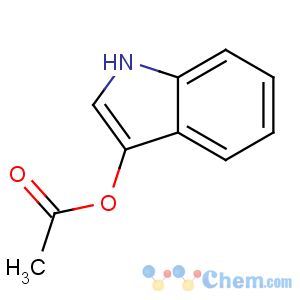3-ACETOXYINDOLE
-
- Product Name3-ACETOXYINDOLE
- CAS No.608-08-2
- Purity98%
- Min Quantity1Kilograms
- Price~

 View Contact Detail
View Contact Detail
-
 Molecular Structure
Molecular Structure
Detailed Description
Indirubin Chemical PropertiesMelting point 350°C(lit.)
Boiling point 496.6±45.0 °C(Predicted)
density 1.417±0.06 g/cm3(Predicted)
storage temp. -20°C
form Purple powder.
pka 9.13±0.20(Predicted)
λmax 540nm(DMSO)(lit.)
CAS DataBase Reference 479-41-4(CAS DataBase Reference)
RTECS DU2995000
HS Code 29339900
Description Indirubin is the active ingredient of Danggui Longhui Wan, a traditional Chinese medicine containing plants such as Indigofera tinctoria L. and Isatis tinctoria L, which are used in traditional Chinese medicine to treat chronic diseases. Indirubin and its analogues are reported as potent inhibitors of cyclin-dependent kinases (CDKs). This could attribute to the positive effect of indirubin on counteracting proliferative diseases, such as chronic myelocytic leukemia (CML), a slowly progressive disease characterized by the overproduction of granulocytes.
References [1] Tina Bla?evi?, Elke H. Heiss, Atanas G. Atanasov, Johannes M. Breuss, Verena M. Dirsch and Pavel Uhrin, Indirubin and Indirubin Derivatives for Counteracting Proliferative Diseases, Evidence-Based Complementary and Alternative Medicine, 2015, vol. 2015, Article ID 654098
[2] Ralph Hoessel, Sophie Leclerc, Jane A. Endicott, Martin E. M. Nobel, Alison Lawrie, Paul Tunnah, Maryse Leost, Eve Damiens, Dominique Marie, Doris Marko, Ellen Niederberger, Weici Tang, Gerhard Eisenbrand and Laurent Meijer, Indirubin, the active constituent of a Chinese antileukaemia medicine, inhibits cyclin-dependent kinases, Nature Cell Biology, 1999, vol. 1, 60-67
Uses Indigopurpurin is a purple 3,2-bisindole derivative and was shown to exhibit inhibitory allergic contact dermatitis via regulating T helper (Th)-mediated immune system in DNCB-induced model.
Uses An inhibitor of GSK-3β and cyclin-dependent kinases.